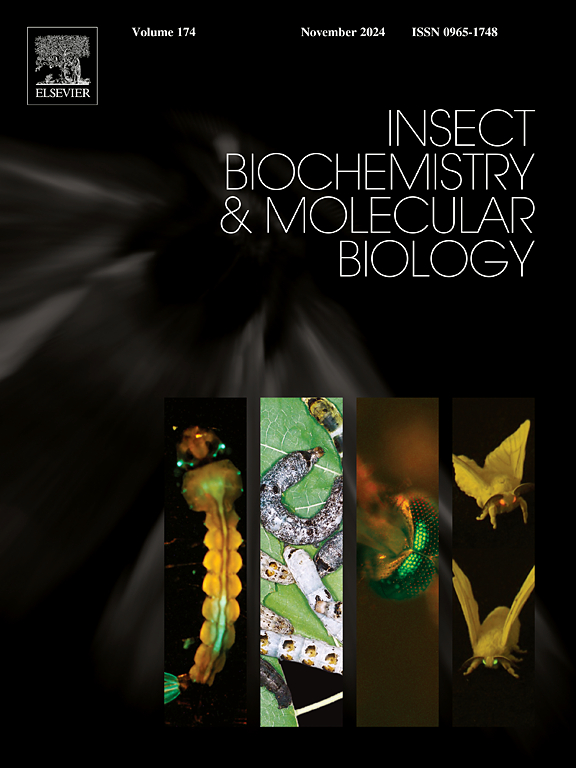The pore canal protein snsl is required for cuticular lipids transport and cuticle barrier function in the migratory locust, Locusta migratoria
IF 3.7
2区 农林科学
Q2 BIOCHEMISTRY & MOLECULAR BIOLOGY
引用次数: 0
Abstract
Lipids are important components of the insect cuticle protecting against desiccation and xenobiotic penetration. Delivery of lipids to the cuticular surface occurs through pore canals, which are a nano-canal system formed by the epidermis, running through the procuticle and terminating at the epicuticle, where they ramify as wax-canals. The molecular mechanisms of cuticular lipids deposition in insects are poorly understood. Here, we identified the pore canal protein Snsl (Snustorr snarlik) in the migratory locust Locusta migratoria (LmSnsl) and investigated its function in cuticular lipid transport and cuticle barrier construction. We found that LmSnsl was specifically expressed in the integument and had a high expression level before ecdysis when a new cuticle is formed. Silencing of LmSnsl by RNA interference (RNAi) caused a lethal phenotype during or shortly after molting. In addition, RNAi against LmSnsl resulted in a decrease in cuticular lipids and in the accumulation of internal lipids. The pore canals of dsLmSnsl animals are deformed and contain less luminal material. Furthermore, we found that cuticle permeability to xenobiotics was enhanced in dsLmSnsl-treated nymphs that were, consistently, more susceptible to insecticides. These animals were also prone to pathogen invasion suggesting that cuticle lipids act in pathogen defense. Taken together, our results indicate that the locust Snsl protein is needed for pore canal integrity required for the transport of lipids from the epidermis to the cuticle to constitute a barrier against xenobiotics and pathogens.

飞蝗(Locusta migratoria)的孔管蛋白snsl是角质层脂质运输和角质层屏障功能所必需的
脂质是昆虫角质层防止干燥和外来生物渗透的重要成分。脂质通过孔管输送到角质层表面,孔管是由表皮形成的纳米管系统,贯穿胚乳,终止于表皮外皮,在表皮外皮分叉形成蜡管。昆虫表皮脂质沉积的分子机制尚不清楚。本研究鉴定了飞蝗(Locusta migratoria, LmSnsl)的孔管蛋白Snsl (snstorr snarlik),并研究了其在角质层脂质转运和角质层屏障构建中的功能。我们发现LmSnsl特异性表达于被膜中,并且在新角质层形成前具有高表达水平。通过RNA干扰(RNAi)沉默LmSnsl可在脱毛期间或脱毛后不久引起致死性表型。此外,针对LmSnsl的RNAi导致角质层脂质减少和内部脂质积累。dsLmSnsl动物的孔管变形,含有较少的管腔物质。此外,我们发现dslmsnsl处理的若虫对外源生物的角质层渗透性增强,这些若虫对杀虫剂一贯更敏感。这些动物也容易受到病原体的侵袭,这表明角质层脂质在病原体防御中起作用。综上所述,我们的研究结果表明,蝗虫Snsl蛋白是孔管完整性所必需的,这是脂质从表皮运输到角质层所必需的,从而构成了抵御外来生物和病原体的屏障。
本文章由计算机程序翻译,如有差异,请以英文原文为准。
求助全文
约1分钟内获得全文
求助全文
来源期刊
CiteScore
7.40
自引率
5.30%
发文量
105
审稿时长
40 days
期刊介绍:
This international journal publishes original contributions and mini-reviews in the fields of insect biochemistry and insect molecular biology. Main areas of interest are neurochemistry, hormone and pheromone biochemistry, enzymes and metabolism, hormone action and gene regulation, gene characterization and structure, pharmacology, immunology and cell and tissue culture. Papers on the biochemistry and molecular biology of other groups of arthropods are published if of general interest to the readership. Technique papers will be considered for publication if they significantly advance the field of insect biochemistry and molecular biology in the opinion of the Editors and Editorial Board.

 求助内容:
求助内容: 应助结果提醒方式:
应助结果提醒方式:


